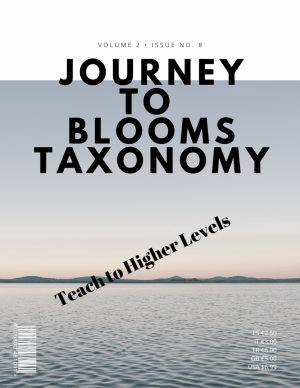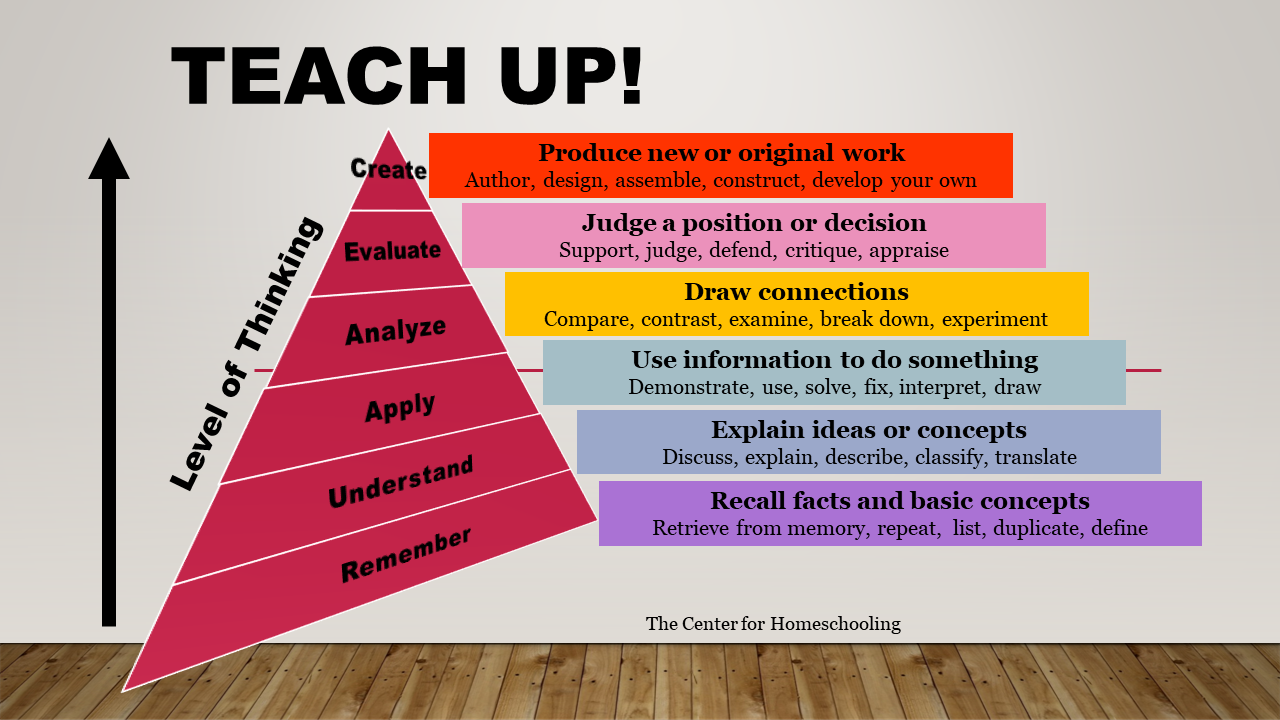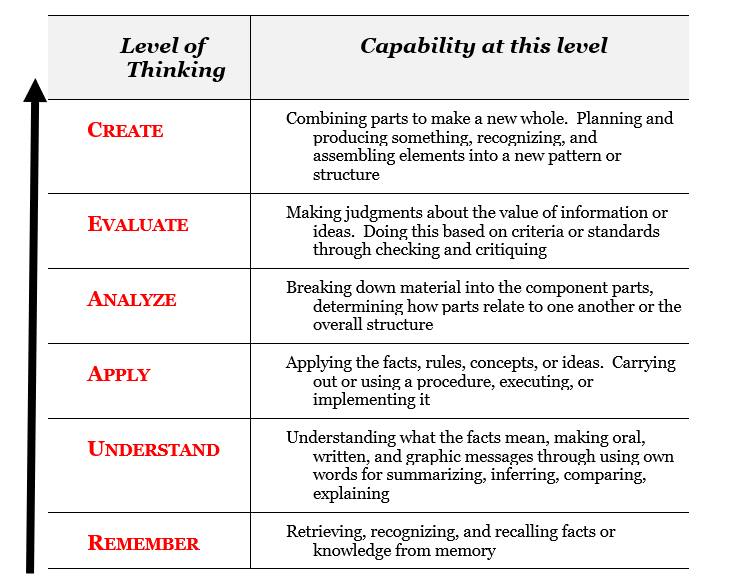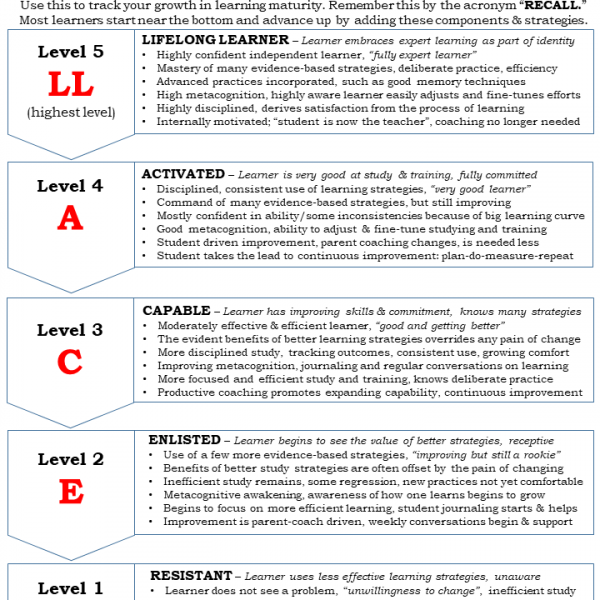
Teach Up!

Reading time: 14 minutes
How to Improve Your Teaching with Bloom’s Taxonomy
Summary
Use this powerful model to expand your homeschool teaching. This article will give you a fundamental building block used by expert teachers – learn about it and start using it. It provides the answer to these common questions:
- How will I ask my kids to demonstrate what they know?
- What questions will I use to promote deeper thinking?
- What level of thinking is my child at in this subject matter?
- What activities should I select to teach higher-level thinking?
Once you read this, you will have a much deeper understanding of learning and you will know how to make better decisions on the learning activities and discussions you lead. Use this as a template to periodically evaluate what and how you teach. Don’t let your kids get stuck because your instruction is limited to the lower levels of the pyramid.
Knowing this taxonomy will improve your confidence – you will know you are teaching the right things in a proper sequence. This article also is supported by another in our parent resources which includes a fun memory exercise to help you recall the key points when you need them.
Background
It seems that the academic side of education has an endless attraction for big words, taxonomy being one. A taxonomy is nothing more than a classification system that arranges elements according to their relationships.
Bloom’s Taxonomy is a hierarchy of six thinking skill levels that describes Cognitive Development. The higher you take your kids in it, the more advanced their thinking. It has many applications.
Bloom’s Taxonomy provides a “quick reference” tool you can use to make decisions on-the-fly as you teach, and it can help you quickly decide what to do next to promote higher thinking.
- Use it to help you determine which level of thinking you need to develop next when you instruct, or use it to help you decide which questions you will be asking your kids as part of your next lesson.
- It’s also a helpful tool for planning your lessons and for deciding what kind of learning outcomes you seek. It’s an insightful and easy-to-understand tool that can make your teaching much more powerful.
- You can also use it to improve your everyday conversations with your kids. It can help uncover your child’s thinking about specific subjects. “What level of knowledge does my child have about something I want them to know?” It’s a great tool to better understand learning.
This model is not new, it originated in the 1950s, but it is still considered one of the most important conceptual tools for educators. What’s great about it is it’s easy to understand and use – you don’t have to be a professional educator to appreciate its value. Use it to guide your selection of classroom discussion techniques.
You can find the six categories of cognitive development in the pyramid below, starting from the simplest level of thinking at the bottom to the most complex at the top. This is an important sequence you should follow when teaching your children, with the bottom levels being normally mastered before you introduce the higher ones. To teach students higher-order thinking skills, you must provide basic knowledge first.
For example, you shouldn’t ask kids to compare and contrast something if you have not taught them first to remember that information, understand it, and analyze it. Before you ask students to apply, analyze, evaluate, and extend what they are learning, you should make sure they have the basic facts, can clarify their understanding and practice recall.
This may seem intuitive, but you do want to use Bloom’s Taxonomy to pay attention to the progression as you teach up the pyramid. It can provide a good double-check to your teaching plan.
Critical thinking exercises deepen students’ understanding and help them recall what they have learned. Bloom helps you determine when and how to promote this.
The two middle “A” levels are particularly important for promoting long-term retention by encouraging retrieval and recitation of information. Use the suggested activities to improve memory and recall.
I recommend you print out the Quick Reference Chart at the end of this article and keep it as a handy reference when you are preparing for a lesson or trying to decide what types of questions you intend to ask to promote deeper thinking. Feel free to share this with other parents.
The Pyramid
Bloom’s taxonomy suggests you start at the bottom. Build knowledge and understanding of basic facts first, then progress upward. Examples are provided on the right of some of the things you might ask your child to do:

Note how the types of activities and questions change as you ascend the pyramid change as you promote and grow more advanced thinking in your kids.
How to Use Bloom’s Taxonomy
The list below summarizes the activities you encourage to stimulate learning at the six levels.
Shorthand descriptions

See the Quick Reference Chart at the end of this article.
The Goldilocks Example
Let’s further illustrate the taxonomy by showing how it might be applied in a classroom situation. This idea was cleverly developed by another researcher, but I don’t remember the source. Review each and compare it to the pyramid chart.
Let’s take the classic – Goldilocks and the Three Bears. Hopefully, you know this story, so I won’t have to explain it to you! If you were teaching a lesson on Goldilocks, you would select exercises that would focus on each of the six levels.
Remember, you would want to start building thinking at the R level and work up as you observe your child demonstrates thinking skills at that level.
Remember: Ask – where did Goldilocks live? What kind of house was it? What kind of animals did she run into? How many?
Understand: Ask – Can you summarize what the Goldilocks story was about?
Apply: Construct a theory of why Goldilocks went to the house. Ask – Why do the different bears prefer different temperatures of soup?
Analyze: Differentiate between how Goldilocks reacted and how you would react in each event. Ask – What would you do if you were Goldilocks?
Evaluate: Assess whether or not you think this actually happened to Goldilocks. Ask – Do you think the baby bear was harmed by this experience? Why?
Create: Compose a poem, song, skit, or rap to convey the story in a new form. Identify other situations in life where there is too little, too much, and just right.
Get the idea? It’s simple but powerful. Some of the best teaching ideas are the easiest to learn. This is one of them.
Conclusion
Good ideas serve you only when you practice them. You’ll become a better instructor when you started using Bloom’s Taxonomy. Start now by taking your very next lesson and building a list of better questions and activities you will ask your child to do. Remember that each level builds on the knowledge you have established in prior levels, so you will want to use this in a building block approach.
Here’s your key points:
- There are six levels of cognitive development. Know them. Use them.
- You begin at the bottom and build higher levels on the knowledge and skills below.
- Thinking about the levels of the taxonomy will make you a better instructor.
- Bloom’s Taxonomy is useful for planning your lessons and preparing better questions.
- Bloom’s Taxonomy will help you plan for better learning outcomes.
- The taxonomy will help you “think on your feet” to better respond to teachable moments as you teach.
- Revisit your kitchen journey in your mind several times over several days until you commit it to long-term memory.
- Use your quick reference chart as a reference whenever you plan learning activities.






